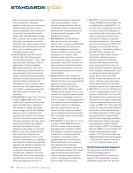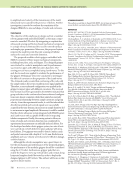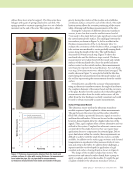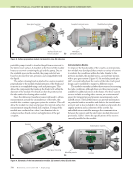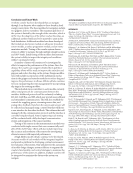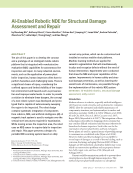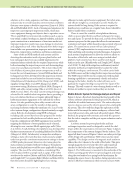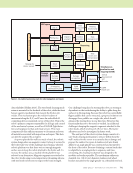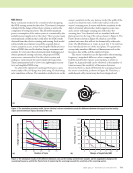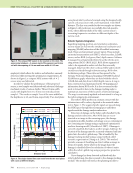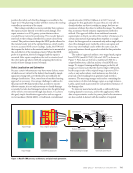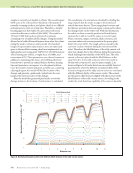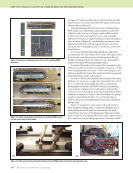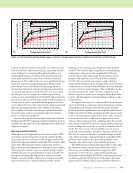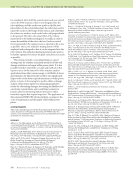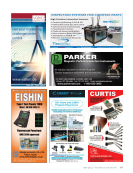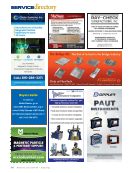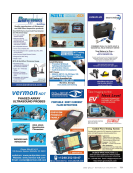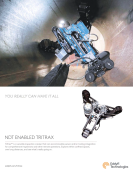J U L Y 2 0 2 1 • M A T E R I A L S E V A L U A T I O N 739 ME TECHNICAL PAPER w A B S T R A C T The aim of this paper is to develop the concept and a prototype of an intelligent mobile robotic platform that is integrated with nondestructive evaluation (NDE) capabilities for autonomous live inspection and repair. In many industrial environ- ments, such as the application of power plant boiler inspection, human inspectors often have to perform hazardous and challenging tasks. There is a significant chance of injury, considering the confined spaces and limited visibility of the inspec- tion environment and hazards such as pressuriza- tion and improper water levels. In order to provide a solution to eliminate these dangers, the concept of a new robotic system was developed and proto- typed that is capable of autonomously sweeping the region to be inspected. The robot design contains systematic integration of components from robotics, NDE, and artificial intelligence (AI). A magnetic track system is used to navigate over the vertical steel structures required for examination. While moving across the inspection area, the robot uses an NDE sensor to acquire data for inspection and repair. This paper presents a design of a portable NDE scanning system based on eddy current array probes, which can be customized and installed on various mobile robot platforms. Machine learning methods are applied for semantic segmentation that will simultaneously localize and recognize defects without the need of human intervention. Experiments were conducted that show the NDE and repair capabilities of the system. Improvements in human safety and struc- tural damage prevention, as well as lowering the overall costs of maintenance, are possible through the implementation of this robotic NDE system. KEYWORDS: AI-enabled robotics, structural damage assessment, eddy current Introduction Modern advances in robotics, especially artificial intelligence (AI) based on neural networks, and nondestructive evaluation (NDE) allow for automated and reliable maintenance of components, structures, and systems subject to surface and subsurface anomalies (Gibb et al. 2018 Ullmann et al. 2020 Ali and Cha 2019 Zhu et al. 2019 Caccamo et al. 2017 Bogue 2010 Meyendorf et al. 2017). The integration of these technologies is favorable for designing robotic systems that may conduct difficult evaluation tasks that may otherwise be hazardous for human inspectors. Such is the case for the examination of power plant boilers and heat exchangers. Power plants are used as a general means of providing energy to consumers on a worldwide scale (Byers et al. 2018). However, boilers and heat exchangers are susceptible to several types of damages as a result of thermal cycling, such as corrosion, fracturing, and aging (Natesan 2002). If these damages are left unchecked, catastrophic failures may occur, which can cause serious problems such as property destruc- tion, hefty repair costs, and loss of life (Musyafa and Adiyagsa 2012). Current available examination methods to prevent these catastrophes are done through human inspection. This method of power plant health analysis is a suboptimal AI-Enabled Robotic NDE for Structural Damage Assessment and Repair by Xiaodong Shi*, Anthony Olvera†, Ciaron Hamilton*, Erzhuo Gao†, Jiaoyang Li*, Lucas Utke†, Andrew Petruska†, Zhenzhen Yu†, Lalita Udpa*, Yiming Deng‡, and Hao Zhang§ Materials Evaluation 79 (7): 739–751 https://doi.org/10.32548/2021.me-04214 ©2021 American Society for Nondestructive Testing * Nondestructive Evaluation Laboratory, Michigan State University, East Lansing, MI 48824, USA † Colorado School of Mines, Golden, CO 80401, USA ‡ Nondestructive Evaluation Laboratory, Michigan State University, East Lansing, MI 48824, USA dengyimi@egr.msu.edu § Colorado School of Mines, Golden, CO 80401, USA hzhang@mines.edu
740 M A T E R I A L S E V A L U A T I O N • J U L Y 2 0 2 1 solution, as it is a risky, expensive, and time-consuming endeavor due to several hazardous environmental conditions that may cause injury or death to inspectors (Lian et al. 2018 Ali and Habibullah 2019). Lack of training and experience for inspectors cause improper inspection results, which may cause equipment damage and injuries due to operation errors. This is amplified by environmental conditions such as opera- tion within confined workspaces, limited visibility, and inade- quate construction or maintenance of structures under test. Improper inspection results may cause damage to structures and equipment as well. Other fatal hazards from boiler inspec- tion include over pressurization, improper water treatment, flameouts, temperature conditions, and furnace explosions. State-of-the-art NDE methods and systems used for detecting discontinuities inside of power plant boilers and heat exchangers have been successfully implemented to minimize human-related risks for required inspections, while both automating the inspection process and decreasing diag- nosis errors and data uncertainties. This in turn reduces the risk of failure of power plant system components as well as lowers the cost of maintenance. Several NDE methods and techniques have been developed for this inspection environ- ment that include but are not limited to ultrasonic testing (Mandeliya and Vishwakarma 2018 Zhang et al. 2020), radi- ographic testing (Baba et al. 2009 Zhang et al. 2020), microwave testing (Korhonen and Ahola 2018 Zhang et al. 2020), and eddy current testing (Zhu et al. 2019 Liu et al. 2020 Yu et al. 2021). The eddy current testing technique was selected for AI-enabled robot integration due to providing a low-cost solution that does not require physically large or hefty measurement equipment to be onboard the robotic device. It is also possible to place eddy current coils in an array configuration to scale the number of data points, increasing resolution within the timeframe of a scan. For the robot system design, configuration depends entirely on appli- cation. Robotic development using NDE techniques including eddy current have been also proposed for similar operations for both mobile platforms and robotic arms. A bespoke configuration with NDE equipment was used for mapping the thickness of water pipelines made of metal, allowing for near-constant liftoffs against pipe walls (Miro et al. 2018). A wall-climbing robot platform was developed for thickness measurements of circulating fluidized bed boilers (Meng et al. 2018). In laboratory or inspection workspace settings, a static robot arm that may reach around a sample under test provides consistent measurement settings in terms of NDE probe placement. However, robot arms placed in static positions are limited without workspace boundaries hence, mobile platforms would be more applicable for larger samples. The size of the robot matters, considering if the robot is placed within a sample such as a pipe. If the robot attaches to the surface (Mattar and Kalai 2018 Kharkovsky and Zoughi 2007) or requires flight (Mattar and Kalai 2018), then the system should be lightweight or have strong adhesion to make up for heavier equipment. For robot arms, end-effector weight is a consideration as well. Finally, the system should be long-lasting. If the system is required to handle severe conditions on a regular basis, then it should be built to handle these conditions. There is a need for a mobile robot platform that may climb on power plant boilers and heat exchangers for inspec- tion and repair. To provide for this need, a novel robotic NDE system is proposed in this paper that allows for autonomous evaluation and repair within hazardous spaces inside of power plants. The autonomous system will use cyber-physical system (CPS) implementation to sweep across a steel plate while analyzing and repairing potential damages. A magnetic track system is implemented to allow the robot to adhere to the surface of the boiler and move using a tracked wheel platform. Such systems have been used for steel-based surfaces in the past (Kharkhovsky and Zoughi 2007 Kumar et al. 2018). To help with navigation, multisensory inertial odometry methods are implemented to localize the robot within the workspace environment. The robot carries both the NDE sensor and the tooling for live inspection and repair. The NDE sensor will be used in conjunction with machine learning capabilities to autonomously classify and analyze damage to the boiler. Finally, the robot will carry, as its payload, the required tooling necessary for live repair of the damage. This will consist of a wire cleaning brush as well as a friction stir welder to repair cracks as they are located. Mobile Robotic System for Damage Analysis and Repair Figure 1 shows a flowchart depicting the functionality of the robotic software subsystem for the proposed CPS, which is called the AI-enabled autonomy stack. The entire subsystem runs in a loop as soon as the robot is powered on, starting the AI system. The robot will then begin the exploration of the boiler until it has swept the entire workspace, collected and stored all necessary data, and made all needed repairs. When finished, the program will terminate and notify the operator that the task is complete and the post-repair evaluation can be conducted. A robotic system for power plant boiler and heat exchanger inspection must be designed to match the chal- lenges within the examination environment. Figure 2 depicts the components of the system designed by the authors. The upper left-hand corner of Figure 2 shows an earlier prototype of the design with a preliminary NDE sensor and no repair capability. The design consists of a magnetic track system to adhere the robot chassis to the walls of the boiler. This gives enough magnetic force to keep the robot and its payload attached to the boiler wall this capability is illustrated in Figure 2. The NDE sensor is mounted to the underside of the robot’s scanning gantry where it is pressed against and swept along the steel surface by a spring-loaded mechanism. By keeping the sensor close to the surface during operation, vari- ations in liftoff are minimized, which in turn increases NDE ME TECHNICAL PAPER w ai-enabled robotic nde for structural damage
ASNT grants non-exclusive, non-transferable license of this material to . All rights reserved. © ASNT 2025. To report unauthorized use, contact: customersupport@asnt.org



























































